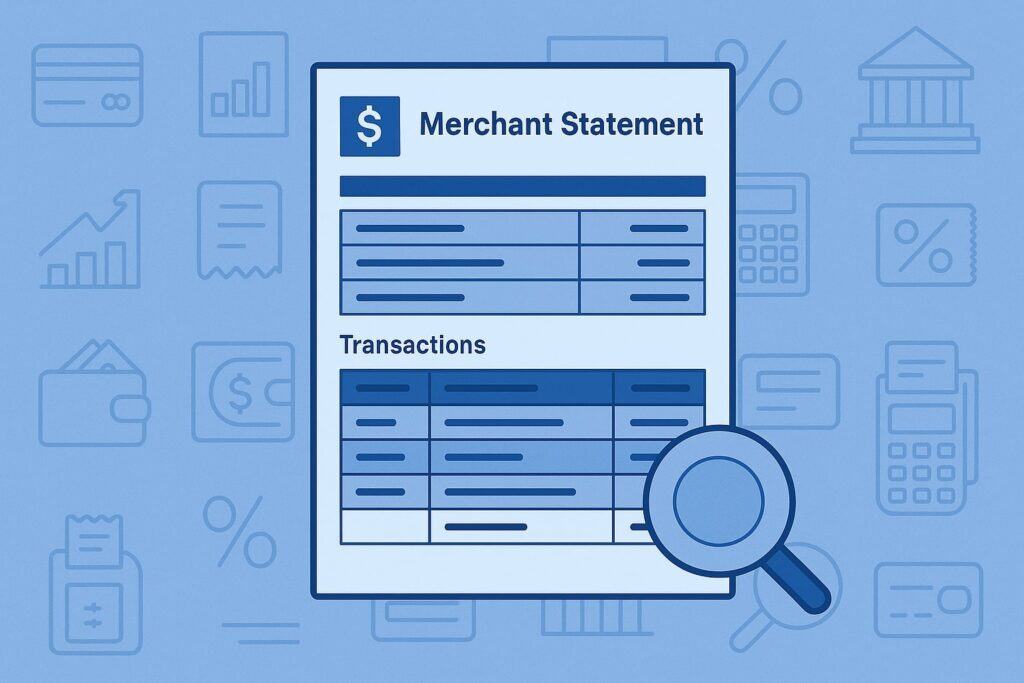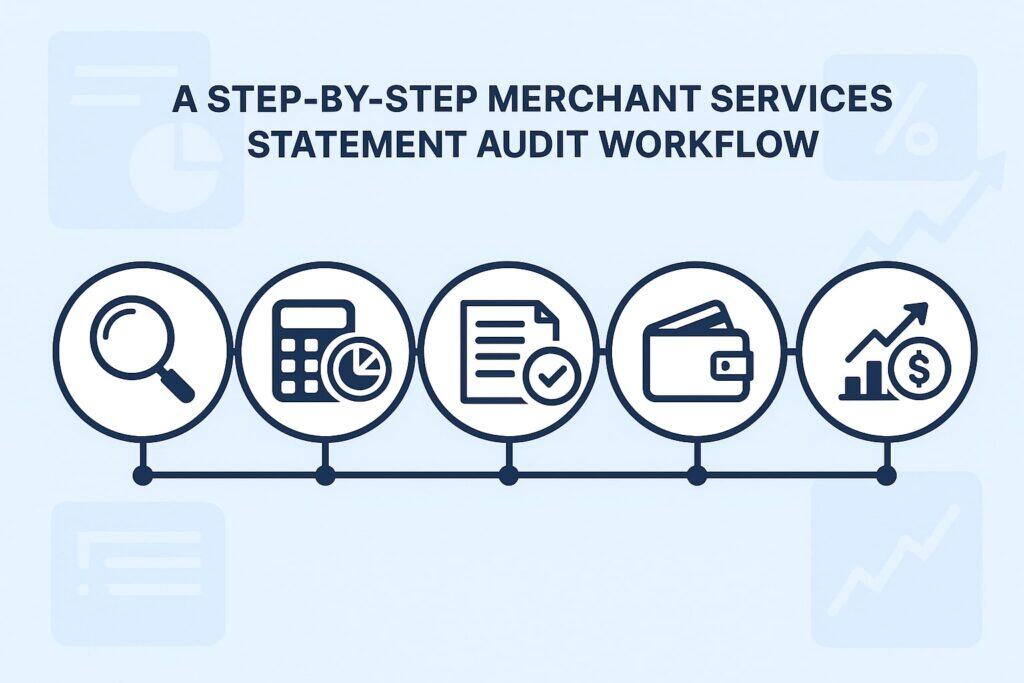
By pittsburgh-merchantservices October 17, 2025
Auditing your merchant services statement is one of the fastest, lowest-risk ways to cut payment costs without changing how you sell. A careful merchant services statement audit lets you verify what you’re really paying for credit card processing, uncover junk fees, and benchmark your pricing against the U.S. market.
Whether you run a Main Street retail shop, a multi-location restaurant group, or a growing eCommerce brand, the same principles apply: read the statement line by line, reconcile deposits, classify fees, and negotiate from data.
This updated U.S.-focused guide walks you through a step-by-step audit process, explains pricing models like interchange-plus and flat rate, decodes pass-through versus processor-added fees, and highlights common traps such as non-qualified downgrades, excessive PCI charges, and inflated chargeback management costs.
You’ll also learn how to build a simple savings model, how to optimize for card-present and card-not-present acceptance, and how to keep your merchant services statement audit running every month with a lightweight checklist.
By the end, you’ll know how to reduce effective rates, tune your authorization settings, and speak the same language as your processor so you can confidently ask for and win better terms.
Why Auditing Your Merchant Services Statement Matters Right Now

A regular merchant services statement audit protects your margins in a climate of rising costs, tighter consumer spending, and frequent changes to network rules.
While you can’t directly change card brand interchange, you can absolutely control the markup you pay on top of interchange, how your transactions qualify, and which optional fees you accept. U.S. businesses commonly discover that their “simple” all-in rate hides higher costs for rewards cards, corporate cards, and keyed transactions.
Others find add-on fees—batch fees, statement fees, regulatory product fees, annual PCI fees, and monthly minimum shortfall fees—that creep in after month three.
By auditing your merchant services statement each month, you calculate your true effective rate (total fees divided by total processed volume), spot seasonal shifts, and separate unavoidable pass-through costs from negotiable processor markups.
An audit also verifies funding: the deposits that hit your bank should match gross sales minus refunds and chargebacks, minus total fees or daily discounting, with timing differences explained.
When you consistently audit your merchant services statement, you prevent silent downgrades, catch configuration errors that push transactions into higher cost buckets, and assemble the evidence you need to renegotiate pricing or switch providers without disruption. This is not busywork—it’s foundational spend control that compounds into meaningful savings.
Understanding the Typical U.S. Merchant Statement Layout

A U.S. merchant services statement usually contains four core sections: summary, card brand detail, fee detail, and deposit/funding activity. The summary tells you processed volume, transaction count, refunds, chargebacks, total fees, and the net you received.
The brand detail breaks out Visa, Mastercard, American Express, Discover, and PIN-debit with volume and average ticket; this is where you’ll gauge mix and qualification.
The fee detail is the heart of your merchant services statement audit: it lists interchange categories (pass-through), assessment fees (card-brand), and processor fees (markup). Interchange lines often appear with cryptic names like “VISA CPS Retail Debit” or “MC Merit I” along with a per-item and percentage.
Assessment lines may read “Visa NABU”, “MC Assessment”, or “Network Access.” Processor fees include monthly statement fees, batch fees, gateway fees, PCI program fees, chargeback fees, retrieval fees, AVS and tokenization fees, and sometimes “regulatory” or “non-compliance” entries that deserve scrutiny.
Finally, the funding section reconciles deposits, chargebacks, and fee timing. Some processors use monthly billing (fees withdrawn in lump sum), others do daily discounting (fees netted from each batch).
For your audit, pull three consecutive statements, export any CSV versions available, and match them to your settlement reports.
Once you know where each number lives on the merchant services statement, you can compute effective rates per brand, identify unusually high per-item costs, and flag anything labeled “miscellaneous,” “support,” or “other.”
Core Fee Categories Decoded for Your Audit
To audit your merchant services statement accurately, you need to classify every line into three buckets: interchange, assessments, and processor markup. Interchange is paid to the issuing bank and varies by card type (debit, credit, rewards, corporate) and how you accept the card (swiped/inserted/tapped vs. keyed).
Assessments are charged by the card brands (Visa, Mastercard, AmEx, Discover) based on volume and sometimes transaction count. Both interchange and assessments are not negotiable with your processor, but your transaction behavior influences which interchange category you hit.
Everything else is processor markup, which is negotiable. In markup you’ll see percentage adders (e.g., 0.20% on top of interchange), per-item adders (e.g., $0.08 per transaction), monthly fees, and program fees (gateway, PCI, chargeback, statement).
During a merchant services statement audit, tag each fee line accordingly and total them by bucket. Your goal is to separate the unavoidable card costs from the optional or inflated costs.
Pay attention to “downgrade” or “non-qualified” categories—these often indicate missing data (like AVS for keyed sales), late settlement (not batching the same day), or mismatched indicators (like Level II/III data not sent for corporate cards).
If you see repeated downgrades, that’s a process issue you can fix to reduce costs. Also inspect “cross-border” and “international” flags; if most of your sales are domestic U.S., these should be rare.
By clearly labeling categories, your merchant services statement audit turns a dense fee list into a map of savings opportunities.
Pricing Models Explained: Interchange-Plus, Tiered, and Flat-Rate
Your audit must identify the underlying pricing model because it shapes where savings exist. Interchange-plus (or “cost-plus”) shows actual interchange and assessments, then adds a transparent processor markup expressed as basis points (e.g., +0.15%) and a per-item fee (e.g., $0.07).
This model makes a merchant services statement audit straightforward and usually cheaper at scale. Tiered pricing groups transactions into “qualified,” “mid-qualified,” and “non-qualified” buckets with fixed rates for each tier.
The issue is that many rewards, corporate, keyed, or eCommerce transactions end up “non-qualified,” making your true cost higher than advertised and harder to audit. Flat-rate pricing charges one simple rate for in-person and another for online, often with no separate statement lines for interchange.
It’s easy to understand and fine for micro-merchants, but as volume and average tickets grow, flat-rate can become expensive because you pay the same premium for low-cost debit as for high-cost premium credit.
In your merchant services statement audit, calculate your effective rate under the current model and simulate costs under an alternative model using your brand mix, card mix, and channel mix.
For example, if you run many debit transactions, interchange-plus typically saves money versus a flat rate. If your provider uses tiered pricing, request a conversion to interchange-plus so downgrades are visible and fixable.
Understanding your model ensures you target negotiations where they matter—on markup, per-item fees, and avoidable downgrades—rather than arguing over card-brand costs you cannot change.
A Step-by-Step Merchant Services Statement Audit Workflow

Begin with data collection. Download the last three to six months of merchant statements, settlement reports, chargeback logs, and gateway invoices, plus your POS or eCommerce order summaries.
Create a simple spreadsheet with tabs for Summary, Brand Mix, Fee Catalog, and Findings. In Summary, enter monthly volume, transactions, total fees, and deposits. In Brand Mix, split volume and counts by Visa, Mastercard, AmEx, Discover, and debit.
In Fee Catalog, copy every line item exactly as printed on the merchant services statement, then tag each as interchange, assessment, or markup.
Next, compute three core metrics for your statement audit: (1) overall effective rate = total fees / total volume; (2) blended per-item cost = total per-item fees / transactions; and (3) debit utilization = debit transactions / total transactions.
Now reconcile funding: if your processor uses monthly billing, verify the single fee debit equals the statement total; with daily discounting, sample a few days to confirm fees netted from the batch match the fee detail.
Move to exception analysis: highlight any “non-qualified” or “standard” categories, fees labeled “regulatory,” “support,” or “non-compliance,” and any PCI-related charges. For each exception, note the likely cause and corrective action.
Finally, quantify savings opportunities: simulate an interchange-plus offer, drop or reduce non-essential monthly fees, right-size per-item costs, and model gateway consolidation if you’re double-paying per-transaction fees. Package your findings in one page with bullets and numbers so you can negotiate from facts.
Monthly Reconciliation That Catches Hidden Leaks
A strong merchant services statement audit includes a fast monthly reconciliation ritual that prevents small leaks from compounding. Start by matching gross sales from your POS or shopping cart to the processor’s batch totals for the month.
Subtract refunds and chargebacks to arrive at net sales. Then, compare the processor’s deposit totals to your bank statement. Any variance should be explainable as timing or fees. If you’re on monthly billing, verify the month’s lump-sum fee debit equals the fee total on your merchant services statement, to the cent.
If you’re on daily discounting, pick five random settlement days and trace each from batch to bank deposit, confirming the processor’s per-day fee deductions align with the itemized fees shown later in the statement.
Keep an eye on “gateway per-transaction” charges—many merchants pay both a processor per-item fee and a separate gateway per-item fee; consolidating can reduce duplication. Record chargeback counts and fees, then divide by total transactions to track your chargeback rate; set alerts if it trends up.
Finally, recompute your effective rate each month and trend it in a simple chart. When the effective rate rises without a corresponding change in card mix or channel mix, you have an actionable audit signal.
This lightweight routine takes minutes once your template is set, and it ensures your merchant services statement audit becomes a repeatable control rather than a one-time event.
Spotting Hidden and Negotiable Fees in Your Statement
Junk fees thrive in the fine print. During your merchant services statement audit, scan monthly fees for “PCI Non-Compliance,” “Regulatory Product,” “IRS Reporting,” “Statement,” “Association,” and “Support” charges.
A legitimate PCI Program fee may be reasonable if it includes a true compliance portal and vulnerability scans, but non-compliance penalties should vanish once you complete your SAQ and any required scans.
Many “regulatory” fees are simply processor markups disguised as pass-throughs; ask for written confirmation of which fees are card-brand assessments versus processor-imposed. Batch close fees, AVS fees on every transaction, and inflated chargeback handling fees are also ripe for negotiation.
Pay special attention to American Express and Discover lines; if your volume is meaningful, you may be able to secure better AmEx OptBlue terms or at least clarify funding timing.
Gateway fees deserve scrutiny too: if your gateway is separate from your processor, you may be paying duplicate per-item costs or tokenization fees. Your merchant services statement audit should also capture annual or semi-annual “maintenance” debits that never show up in the monthly breakdown.
Ask your provider to enumerate every current and potential fee in a single schedule; then memorialize any concessions in an addendum so the savings persist. The goal of your audit is not only to remove today’s extras but to block tomorrow’s surprises by locking your pricing, markup, and fee list in writing.
Interchange Qualification and Optimization Opportunities
While you can’t set interchange, you can influence how your transactions qualify—often the biggest lever in a merchant services statement audit. For card-present sales, ensure your POS supports EMV and contactless, captures ZIP code or AVS when required, and batches the same day to avoid “late presentment” downgrades.
For card-not-present or eCommerce sales, enable AVS and CVV, send order value, tax, and customer code fields when available, and consider 3-D Secure for liability shift on fraud-risk transactions.
Business, corporate, and purchasing cards can qualify for lower interchange when you pass Level II/III data (tax amount, invoice number, item details).
If your merchant services statement shows lots of “Standard” or “Non-Qualified” categories, ask your gateway or processor which data elements your current integration is missing. Also review MCC (merchant category code) accuracy and settlement timing; both can impact qualification.
Finally, analyze average ticket size: small-ticket programs reduce per-item costs for very low tickets, while high-ticket best practices aim to avoid unnecessary card-not-present downgrades.
By tightening these operational details, your merchant services statement audit uncovers durable, non-negotiation savings—payments you stop overpaying because transactions qualify correctly at the interchange level.
Pair these improvements with markup reductions and compound savings across both the card-brand and processor layers.
Industry-Specific Traps and Best Practices (Retail, Restaurants, eCommerce, Professional Services)
Different U.S. industries face distinct fee drivers, which your merchant services statement audit should reflect. Retailers with lots of debit should verify they aren’t paying credit-like rates on regulated debit; small per-item costs matter with low average tickets, so look for small-ticket optimizations.
Restaurants often suffer from tips added after authorization; if adjustments exceed certain thresholds or batches settle late, transactions can downgrade. Make sure your POS supports tip adjustment best practices and same-day settlement.
eCommerce merchants live with higher card-not-present interchange and fraud risk; here, AVS, CVV, velocity checks, and 3-D Secure can reduce fraud and chargeback fees. Use address normalization and tokenization to improve authorization rates, because every re-attempt adds gateway and per-item costs.
Professional and field services frequently key cards or invoice for larger amounts; explore Level II/III data for commercial cards and consider secure pay-by-link to avoid keyed downgrades.
Subscription businesses should review network rules on recurring transactions and ensure the proper indicators are passed to limit declines and reduce fees on retries. In every vertical, your merchant services statement audit should compare location performance: if one store’s effective rate is higher, investigate staffing, device configuration, or batch timing differences.
Tailoring your audit to your industry ensures you don’t apply a generic playbook when specific, easy wins are available based on how your customers pay and how your systems are configured.
Card-Not-Present, Surcharging, and Convenience Fee Considerations in the U.S.
If you accept payments online, by phone, or via invoice, your merchant services statement audit must address card-not-present economics and rules. Card-not-present transactions carry higher interchange due to fraud risk, so you need layered controls that both protect authorization rates and keep costs down.
Enable AVS and CVV checks, use fraud tools that score risk before authorization, and pass recurring or installment indicators for subscriptions. If you’re evaluating surcharging or convenience fees to offset costs, remember that U.S. rules vary by card brand and state restrictions exist.
Surcharging typically applies only to credit cards (not debit), must be disclosed clearly, and is capped by brand limits; convenience fees have different rules and often apply when you offer an alternative, non-standard payment channel.
Your audit should confirm whether your current processor settings block surcharges on debit cards, whether your receipts disclose fees correctly, and whether your pricing program is consistent across channels.
Consider cash discount programs cautiously; ensure the program is compliant, presented transparently, and doesn’t create chargeback exposure.
Even if you don’t implement a fee pass-through, your merchant services statement audit may show that simply steering to lower-cost options—such as offering debit-friendly routing or ACH for invoices—reduces your effective rate without customer friction.
Always document your approach, train staff, and test your checkout to avoid accidental non-compliance that can show up later as costly adjustments or assessments.
Building a Data-Driven Savings Plan from Your Audit
A great merchant services statement audit ends with a quantified roadmap, not just observations. Start by ranking opportunities by annualized savings and effort.
For example, moving from tiered to interchange-plus might save 20–60 basis points with moderate effort; fixing late batch settlement could save 5–15 basis points with low effort; enabling Level II/III for B2B invoices might save 10–30 basis points on that segment with moderate effort; trimming PCI and statement fees might save a flat $20–$50 per month with minimal effort.
Build a simple financial model: current effective rate versus target effective rate, multiplied by projected volume, plus fixed fee reductions. Add sensitivity scenarios for volume growth and mix changes.
Then translate actions into owners and deadlines: gateway config tasks for your developer, POS settings for your operations lead, and pricing negotiations for finance.
Include a control plan—monthly reconciliation, quarterly pricing review, and semiannual qualification spot checks. Put the “before and after” numbers in a one-page executive summary you can share with leadership or your processor.
When you quantify the plan, it’s much easier to secure cooperation from stakeholders and to hold vendors accountable. A merchant services statement audit is only as valuable as the savings it creates; by making the roadmap explicit, you turn analysis into results.
Negotiation Scripts, Benchmarks, and What to Ask For
When it’s time to negotiate, use the language your merchant account provider understands. Lead with facts from your merchant services statement audit: “Our last three months show $X in volume, Y transactions, and a Z% effective rate.
Our card mix is A% debit, B% standard credit, and C% premium/rewards. We’re on tiered pricing with frequent non-qualified downgrades.” Then ask for interchange-plus with a specific target markup: basis points and per-item.
For example, “We’re seeking interchange-plus 0.15% and $0.07 per item,” or whatever is appropriate for your size and risk. Request elimination or reduction of monthly statement fees, PCI non-compliance fees (with compliance achieved), and any ambiguous “regulatory product” charges.
If you bring gateway volume, ask for bundled gateway pricing or tokenization included. For chargebacks, ask for lower handling fees if your rate is low and dispute volumes are minimal. If you process significant AmEx, ask about OptBlue terms and funding timing.
Always get a fee schedule addendum that lists every possible fee and locks your markup for a defined period. If they won’t meet your target, ask for volume-based tiers or a rate review clause.
The key is to keep the conversation anchored to the metrics you computed during your merchant services statement audit. Vendors respond to prepared merchants; arriving with a clean spreadsheet, clear ask, and competitive alternatives dramatically improves outcomes.
Compliance, Program Choices, and Risk Settings That Affect Cost
Cost and compliance are linked. Your merchant services statement audit should confirm that you’re completing PCI DSS requirements appropriate to your environment: SAQ A for hosted-payment eCommerce, SAQ B or B-IP for standalone terminals, SAQ P2PE for validated P2PE solutions, and SAQ D for custom integrations.
Finishing the correct SAQ and passing quarterly scans, if required, removes non-compliance penalties that inflate your effective rate. Review risk settings, too: extremely strict fraud filters may reduce approvals and shrink revenue, while too-loose rules invite chargebacks and fee escalation.
Look for a balanced approach aligned to your actual fraud profile. If you store cards, ensure tokens are managed correctly and vault providers meet security standards; token fees add up, but the authorization uplift and chargeback reduction can justify them.
For surcharging, convenience fees, or cash discounting programs, document disclosures and receipts, confirm debit handling, and periodically test transactions to avoid accidental rule violations that show up as assessments.
Finally, verify that your MID, MCC, descriptor, and settlement bank details are accurate; mismatches can create funding delays or misrouted chargebacks that add administrative cost. By weaving compliance checks into your merchant services statement audit, you keep fees down while protecting your ability to accept cards without interruption.
Tools, Spreadsheets, and Ongoing Monitoring for Your Audit
Turn your merchant services statement audit into a repeatable playbook with a few simple tools. Build a Google Sheets or Excel template that ingests monthly statement data, tags each fee as interchange, assessment, or markup, and automatically computes effective rate and per-item averages.
Include brand-mix pivots and a chart that trends your effective rate and authorization rate. If your processor or gateway offers CSV exports, automate the copy-paste to reduce errors. Create a checklist for month-end: reconcile deposits, sample daily batches, review chargeback log, confirm PCI status, and compare this month’s fee catalog to last month’s.
Add thresholds that trigger review—e.g., effective rate increases by >10 basis points, non-qualified downgrades exceed 3% of volume, or chargeback rate crosses 0.9%. If you have multiple locations or channels, set up a simple scorecard so you can spot outliers quickly.
Keep a vendor file with your signed fee schedule and any addenda; when a new line appears on the merchant services statement, you can check whether it’s permitted.
Finally, calendar a semiannual strategic review where you refresh benchmarks, revisit your pricing model, and test the market with a competitive quote. Sustained savings come from consistent visibility; with a lightweight toolkit, your merchant services statement audit becomes a habit that quietly protects profit every month.
FAQs
Q.1: How do I calculate my effective processing rate from my merchant services statement?
Answer: Add all fees for the month (including gateway, PCI, chargebacks, monthly fees), then divide by total processed volume. That percentage is your effective rate. Repeat monthly to track trends. If it rises without a change in mix, your merchant services statement audit should look for new fees, downgrades, or a markup increase.
Q.2: What’s the difference between interchange and processor markup?
Answer: Interchange and assessments are set by the card networks and issuers; you influence them via how you transact and data quality, but you don’t negotiate them directly. Processor markup is everything the provider adds—basis points, per-item fees, monthly fees, and program fees. In a merchant services statement audit, markup is where you negotiate.
Q.3: Is flat-rate pricing ever a good idea?
Answer: Yes, for very small volume or when simplicity matters more than optimization. But as your debit mix or ticket size grows, a detailed merchant services statement audit often shows interchange-plus is cheaper because it passes through lower debit costs rather than charging the same rate for every card type.
Q.4: What are the biggest red flags on a statement?
Answer: Frequent “non-qualified” categories, unexplained “regulatory” or “support” fees, persistent PCI non-compliance penalties, high chargeback handling fees, and duplicate gateway/processor per-item charges. Your merchant services statement audit should also flag batch timing issues and missing AVS/Level II/III data.
Q.5: How often should I audit?
Answer: Do a quick merchant services statement audit monthly and a deeper review quarterly. Pair it with a semiannual market check to ensure your markup remains competitive as your business and card mix evolve.
Conclusion
A thorough merchant services statement audit transforms an opaque cost center into a controllable, predictable expense. By breaking your statement into interchange, assessments, and markup, you separate non-negotiable network costs from fees you can optimize or eliminate.
You then tune how transactions qualify—through same-day batching, complete AVS/CVV, and Level II/III data—so you pay the right interchange rather than inflated “non-qualified” rates. You reconcile deposits monthly to catch leaks early, and you negotiate with confidence because you arrive with a clear effective rate, a clean fee catalog, and quantified savings scenarios.
For U.S. merchants, this discipline is a strategic lever: over a year, shaving even 20–40 basis points can fund marketing, staffing, or technology that drives growth. Treat your merchant services statement audit as an ongoing control, not a one-time project.
Keep your spreadsheet simple, your checklist short, and your vendor documentation tight. When you build this habit, you protect margins, reduce surprises, and ensure your payment stack supports your business—not the other way around.